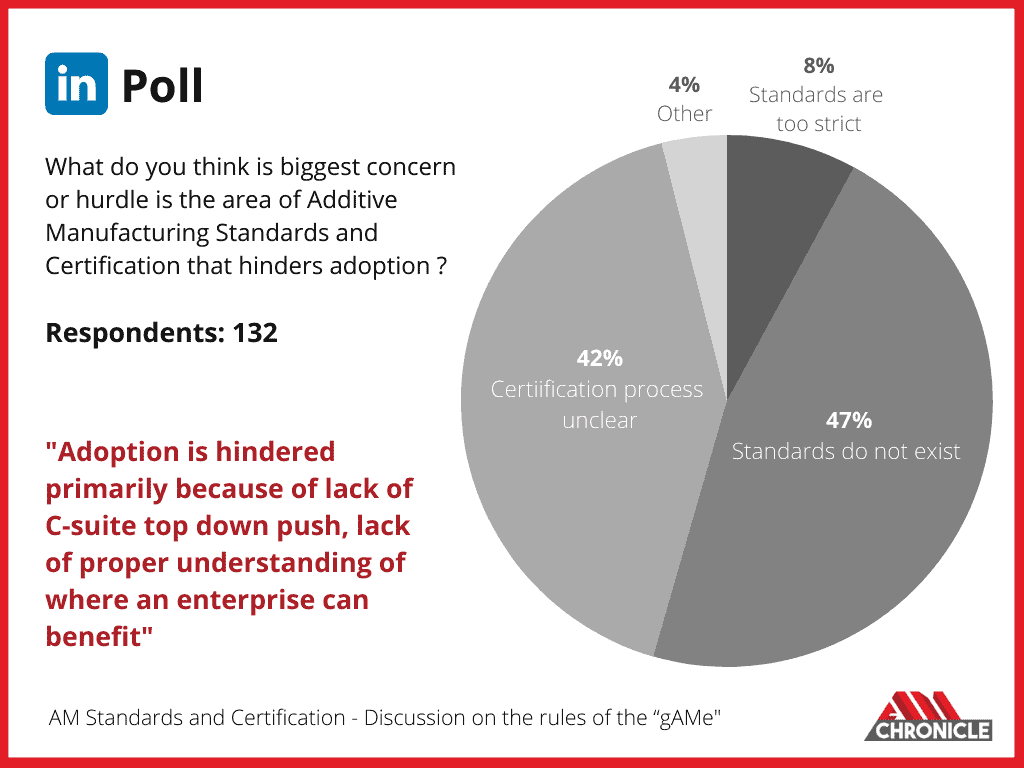Standards can positively contribute to the development and adoption of a new technology such as additive manufacturing (AM), however some stakeholders in the AM industry and its supply chain may believe that the standards are a burden because it may add significant cost to product price. In this article let us examine the need for standards and how standards adoption can help to boost technology adoption.
A big challenge that the AM industry needs to address to be more widely accepted and adopted is the concern regarding the variations in part quality from build to build. Is this a mere concern or a myth or a reality? Does anybody know the answer? Well, it seems nobody knows the precise answer. Why because to know there are variations you need to first identify and quantify the variations based on certain scientific principles and compare them. How can we do that? One can do this by using relevant standards and certification.
If we look at the biggest obstacles to AM, we can think of many topics including but not limited to slow production rates, high production costs, non-automatable processing steps, big data silos, lack of skilled workforce etc. If the principal question regarding part-to-part variation remains unsettled, then the technology usage will continue to rise but trust will not grow. The loss of trust may create a vicious circle which might not be easy to break. Hidden costs we pay due to lack of trust is something we don’t realize or don’t know or don’t want to know.
Since part-to-part quality variation is linked to production control and effective quality assurance using right standards can ensure the quality and reliability of AM parts.
Here I try to list some of the benefits of using standards-based certification
- Traceability
- Fit for purpose / it will work when needed
- Compliance with regulations
- Insurance pre requirement
- Statutory, Legal requirement
- Security, Piece of mind
- Avoid catastrophes / Risk mitigation
- Protect life, property, environment
- Protect your rights, avoid court case
- To avoid contractual conflicts
- Effective communication
- Transparency in requirements
An example list of additional tasks one must think when they need to comply a standard are
- Additional documentation
- Additional audit
- Additional testing
- Additional cost
- Involving third party
Despite the additional tasks related to certification, one can achieve cost effective certification by following means :
- Understand documentation, testing, inspection requirements to avoid unnecessary work
- Choose an expert third-party organisation with knowledge and technical abilities
- Involve third-party from early planning stage for good advice on cost-effective certification and / reuse knowledge from trial testing phase
With standards, end users can compare apples to apples and make right decisions and manufacturers can prove that they deliver parts that meet the contract obligations as a result this can benefit the whole eco system.
In October 2021, we conducted an online survey on Linkedin reaching out to key stakeholers in the industry to understand the priorities of AM community.
Extracts from the comments:
- Adoption is hindered primarily because of lack of C-suite top down push, lack of proper understanding of where an enterprise can benefit
- Challenge is it has too many variables.
- The cost and knowledge barrier are very, very high now.
- A lot of knowledge and best practices are kept confidential. This is a big barrier to adoption.
- Not only do the standards not exist, I’m not sure we know what needs to be measured. The benefit of making assumptions early on, is that it allows you to progress. The downside is that some of the assumptions get confused as requirements.
- We are just starting out to understand the certification process, but it is difficult to get firm answers to tell us what to do from various interested parties.
- Unless you know what you are creating a standard for you could potentially go around in circles and spend money on R&D where only 10% of that makes it all the way through.
- Standards benefit from consensus around best practices, which are still being discovered.
Thank you to all participants for sharing their valuable insights. We will provide expert commentary on these points in our next articles of this series. Please stay tuned.



